I know it's all about stretching yourself and playing on the lathe, so I'll whisper it, but you could have just used ordinary brass screws into a shallower countersinking, then milled or filed off the bits with the slots in. Apparently it's what lots of infill makers did. 
-
Hi all and welcome to TheWoodHaven2 brought into the 21st Century, kicking and screaming! We all have Alasdair to thank for the vast bulk of the heavy lifting to get us here, no more so than me because he's taken away a huge burden of responsibility from my shoulders and brought us to this new shiny home, with all your previous content (hopefully) still intact! Please peruse and feed back. There is still plenty to do, like changing the colour scheme, adding the banner graphic, tweaking the odd setting here and there so I have added a new thread in the 'Technical Issues, Bugs and Feature Requests' forum for you to add any issues you find, any missing settings or just anything you'd like to see added/removed from the feature set that Xenforo offers. We will get to everything over the coming weeks so please be patient, but add anything at all to the thread I mention above and we promise to get to them over the next few days/weeks/months. In the meantime, please enjoy!
You are using an out of date browser. It may not display this or other websites correctly.
You should upgrade or use an alternative browser.
You should upgrade or use an alternative browser.
Mixed Media - Making a wood & metal plane
- Thread starter Dr.Al
- Start date
Dr.Al
Old Oak
I know it's all about stretching yourself and playing on the lathe, so I'll whisper it, but you could have just used ordinary brass screws into a shallower countersinking, then milled or filed off the bits with the slots in. Apparently it's what lots of infill makers did.
Good point, but that's not as simple as you might think. The only wood screws I have are torx head ones in plated steel. I've got a few brass machine screws (almost certainly in a different grade of brass), but nothing for wood.
Okay, I could have gone shopping, but where's the fun in that?! Besides, I hate slotted screws (both functionally & aesthetically), so buying them just seems wrong
Mike G
Petrified Pine
I had to quote your post to be able to read it.........but yep, that makes sense.I know it's all about stretching yourself and playing on the lathe, so I'll whisper it, but you could have just used ordinary brass screws into a shallower countersinking, then milled or filed off the bits with the slots in. Apparently it's what lots of infill makers did.
Dr.Al
Old Oak
You can click on the blurry text to make it appear (only tested on a phone browser but I assume it's the same on a PC/Mac).I had to quote your post to be able to read it.........but yep, that makes sense.
It is.You can click on the blurry text to make it appear (only tested on a phone browser but I assume it's the same on a PC/Mac).
Haven’t worked out how to create that blurred text though.
I expect one or two forum members would have been happy to send you four screws in an envelope, just for the pleasure of watching you make another plane!Okay, I could have gone shopping, but where's the fun in that?!
Dr.Al
Old Oak
In the text formatting options, there's a thing (next to the underline icon) that looks (a little) like a mask.It is.
Haven’t worked out how to create that blurred text though.
Dr.Al
Old Oak
That probably would have been a better option than making them myselfI expect one or two forum members would have been happy to send you four screws in an envelope, just for the pleasure of watching you make another plane!
Part of my (probably spurious) justification for making them was that I wanted to be sure that the grade of brass (CZ121) used for the screws was the same grade as that used for the base plate. I've got some brass round bar that's a noticeably different colour to the normal CZ121 stuff & if there had been a substantial discrepancy then it would probably have been obvious.
Dr.Al
Old Oak
Gluing the parts together didn't go entirely according to plan. The first three screws went in reasonably easily and tightened nicely. The last one snapped off:
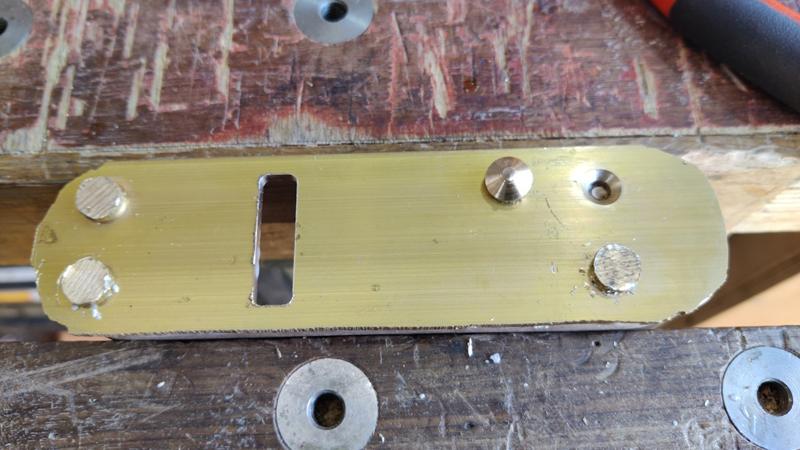
To deal with that, I took the body over to the pillar drill and used a 5 mm spotting drill to drill out the screw.
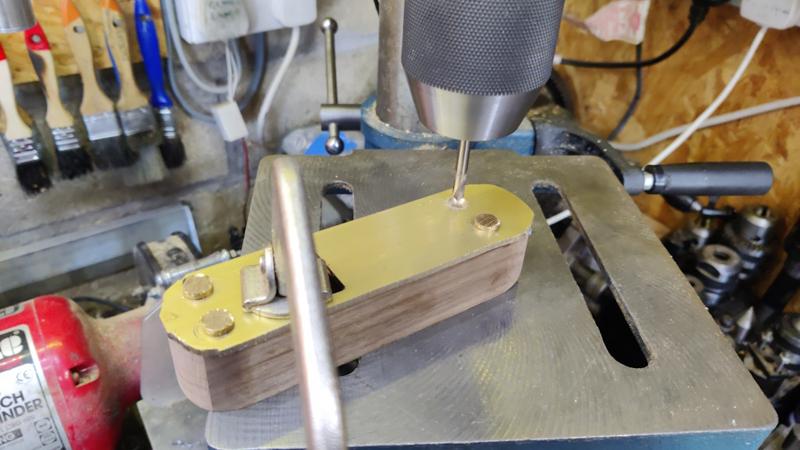
I thought of a couple of ways of dealing with the remaining hole and decided to go with the easier and quicker option with a more complicated option as a fall-back. I quickly turned a new part that I'm calling an "epoxy screw". This isn't threaded as such, but has a couple of shallow grooves cut into it to give somewhere for some epoxy to go into and hopefully give the epoxy a better grip on the brass:
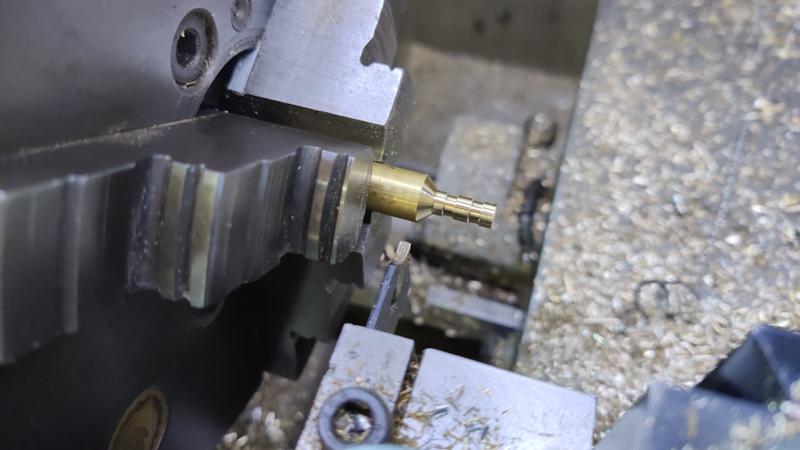
It got slathered in epoxy and some more got shoved in the hole and then the "epoxy screw" got pressed in and then clamped firmly in the vice:
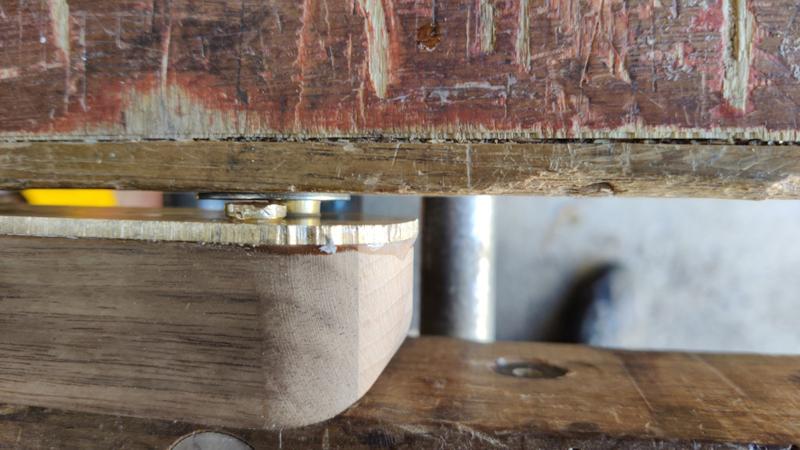
My fall-back option if that hadn't worked would have been to drill and tap a hole in the base and body and then use a home-made machine screw to fill the hole.
Once the epoxy had been left for 24 hours to cure, I wrapped the body in masking tape (to try to keep any oil away from the wood) and mounted it in the mill vice:
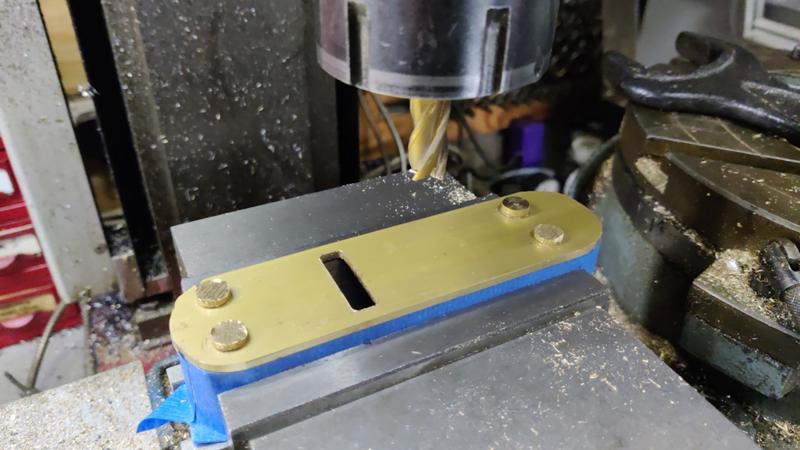
I used an end mill to reduce the thickness of the screw heads to about 0.5 mm:
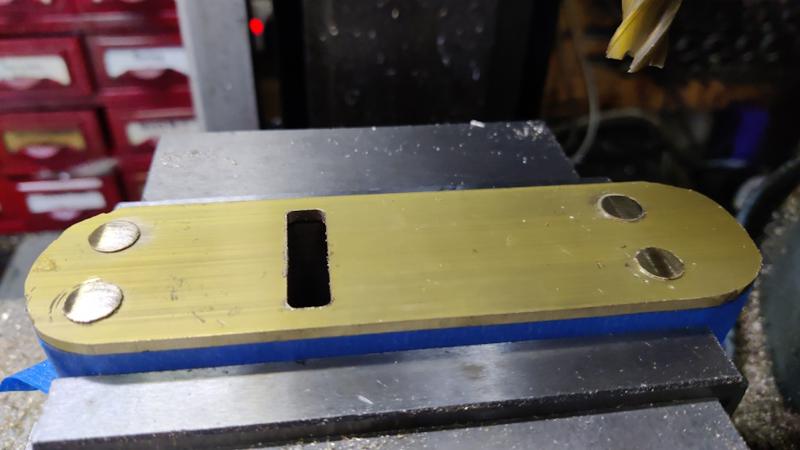
I then peened the edges of the screw heads using a ball-peen hammer:
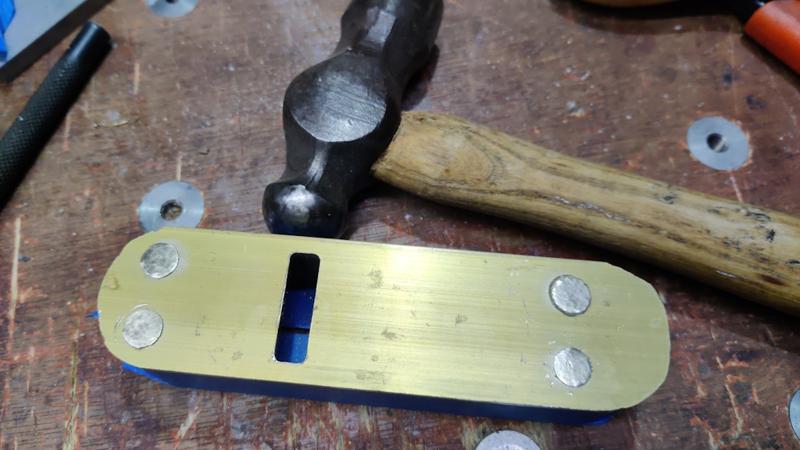
The first two (at the rear of the plane) were done just with the ball-peen hammer, but I was struggling with accuracy. On the second two (at the front of the plane) I decided to try an alternative approach and held a pin punch on the edge of the screw head and hit the pin punch with the hammer.
Once the heads were peened a bit (I've never done this before so I'd no idea whether I'd done enough), I put some 80 grit sandpaper on the bandsaw table and started attacking the bottom of the plane:
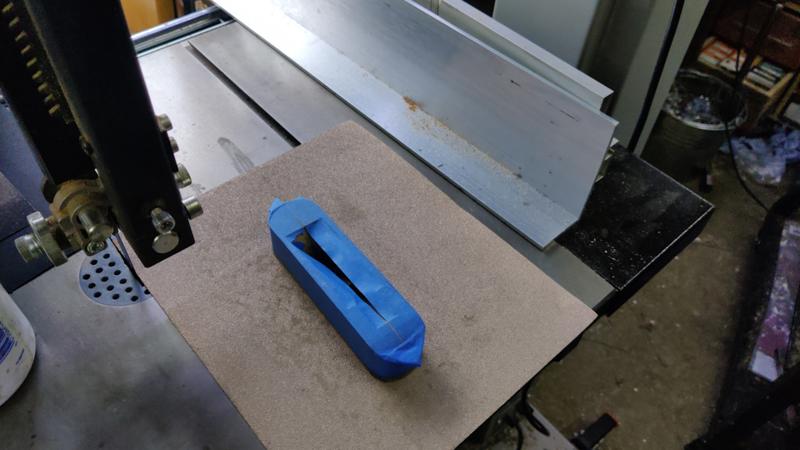
I kept sanding with the 80 grit sandpaper until there wasn't even the slightest sign of any remaining will-to-live, then switched to 120 grit wet-and-dry:
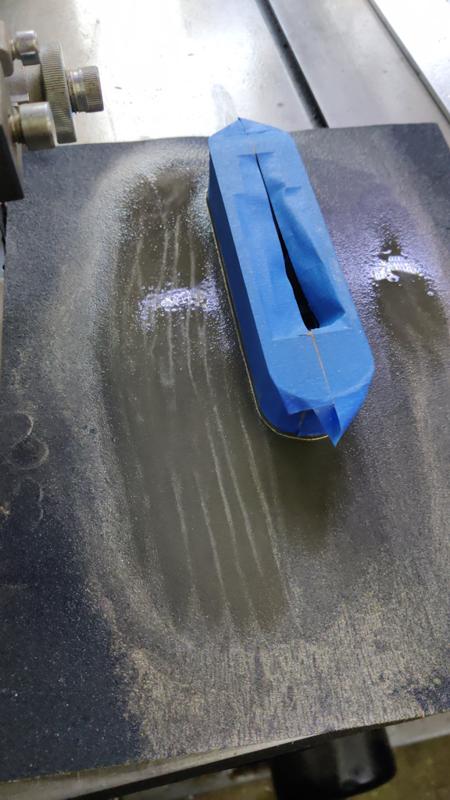
After that I gave it a bit of attention (but probably not enough, bearing in mind I was rather fed up with sanding at this stage) with 180 grit and 240 grit and then decided I'd definitely had enough for now.
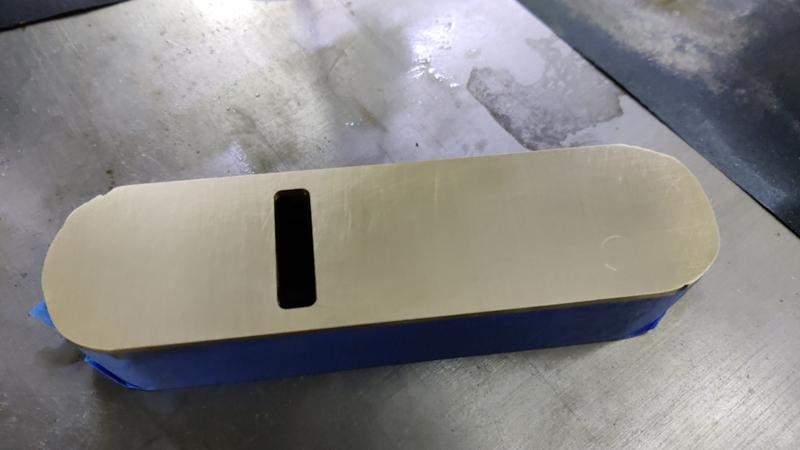
The two screws that were peened with the pin punch look really good:
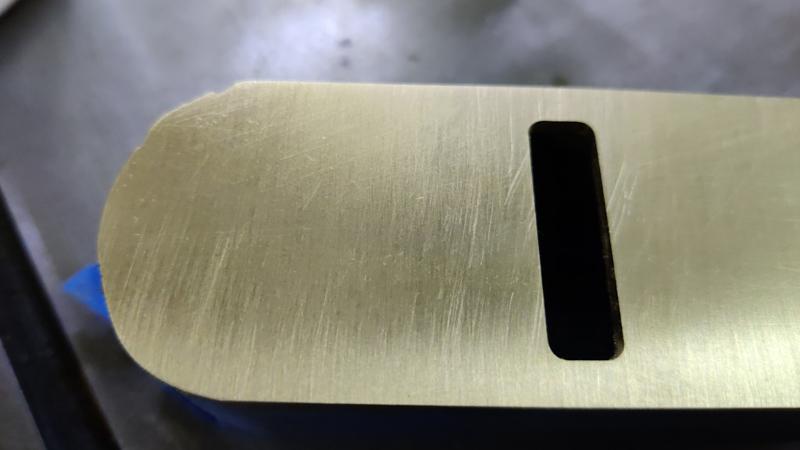
The two that were peened with the hammer aren't quite as good, but they'll have to do:
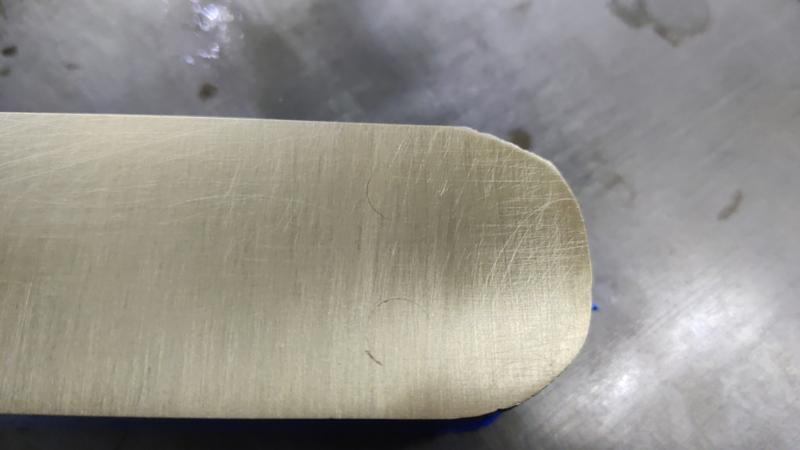

To deal with that, I took the body over to the pillar drill and used a 5 mm spotting drill to drill out the screw.

I thought of a couple of ways of dealing with the remaining hole and decided to go with the easier and quicker option with a more complicated option as a fall-back. I quickly turned a new part that I'm calling an "epoxy screw". This isn't threaded as such, but has a couple of shallow grooves cut into it to give somewhere for some epoxy to go into and hopefully give the epoxy a better grip on the brass:

It got slathered in epoxy and some more got shoved in the hole and then the "epoxy screw" got pressed in and then clamped firmly in the vice:

My fall-back option if that hadn't worked would have been to drill and tap a hole in the base and body and then use a home-made machine screw to fill the hole.
Once the epoxy had been left for 24 hours to cure, I wrapped the body in masking tape (to try to keep any oil away from the wood) and mounted it in the mill vice:

I used an end mill to reduce the thickness of the screw heads to about 0.5 mm:

I then peened the edges of the screw heads using a ball-peen hammer:

The first two (at the rear of the plane) were done just with the ball-peen hammer, but I was struggling with accuracy. On the second two (at the front of the plane) I decided to try an alternative approach and held a pin punch on the edge of the screw head and hit the pin punch with the hammer.
Once the heads were peened a bit (I've never done this before so I'd no idea whether I'd done enough), I put some 80 grit sandpaper on the bandsaw table and started attacking the bottom of the plane:

I kept sanding with the 80 grit sandpaper until there wasn't even the slightest sign of any remaining will-to-live, then switched to 120 grit wet-and-dry:

After that I gave it a bit of attention (but probably not enough, bearing in mind I was rather fed up with sanding at this stage) with 180 grit and 240 grit and then decided I'd definitely had enough for now.

The two screws that were peened with the pin punch look really good:

The two that were peened with the hammer aren't quite as good, but they'll have to do:

Dr.Al
Old Oak
The next job on the body was to open the mouth out. I'm not a big fan of filing, so I thought I'd save myself a little bit of effort by using a long end mill to get rid of some of the waste:
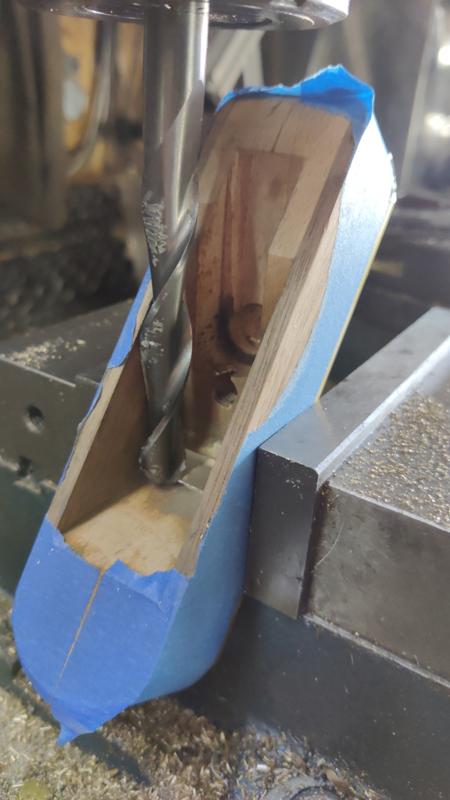
That left the mouth looking like this:
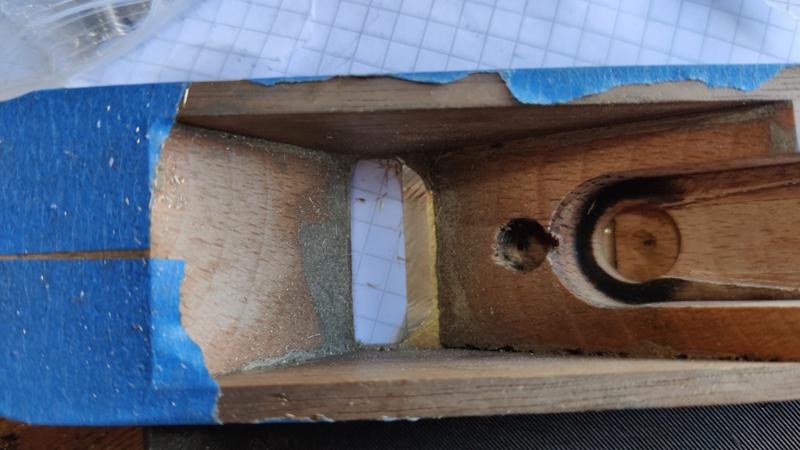
My portable workbench provided a handy method of holding the body a bit higher up to make the filing job more comfortable:
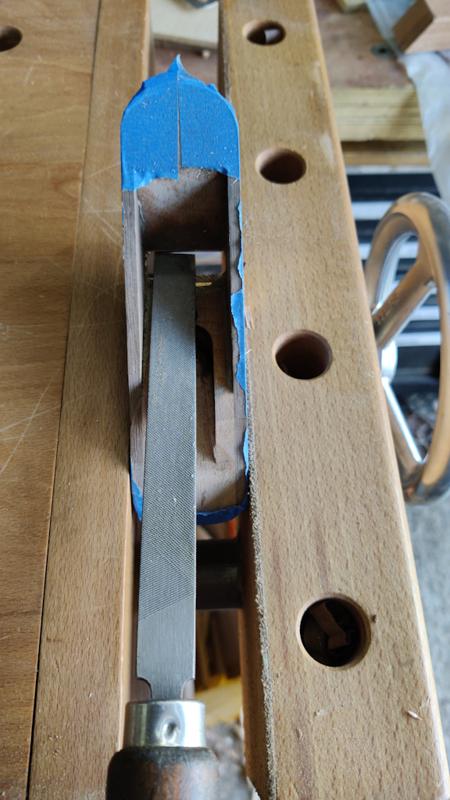
After filing:
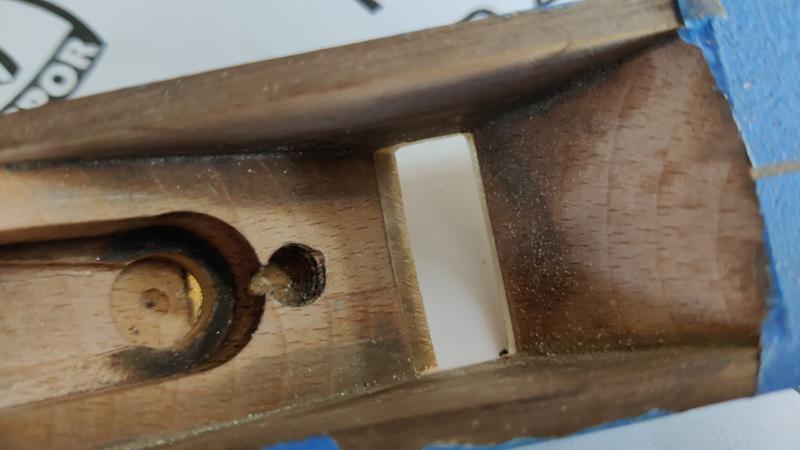
I want the sides of the plane (especially the right-hand side) to be at 90° to the base and I was a bit concerned that if I just attacked the sides of the brass base with a file, I could easily file away some of the wood and end up out-of-square. To avoid that, I got an angle plate and taped some UHMW-PE tape to it (UHMW-PE is very low friction tape):
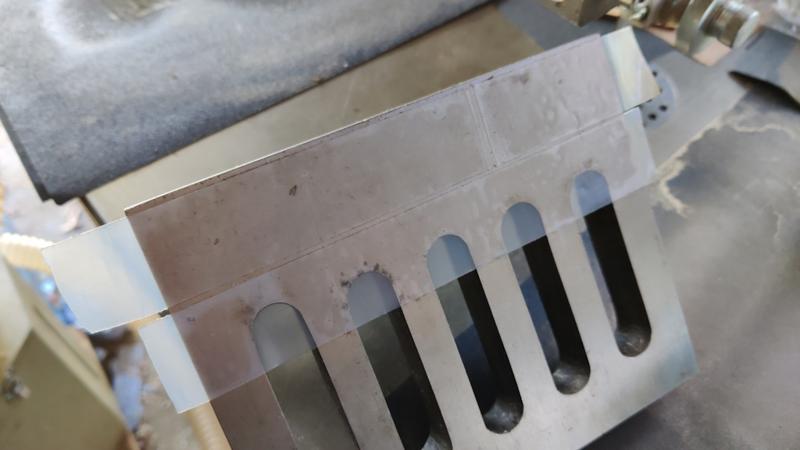
After clamping the angle plate down to the bandsaw table and pushing a sheet of 120 grit wet-and-dry paper up against it, I could press the base of the body against the taped angle plate and rub it back and forth to sand the side:
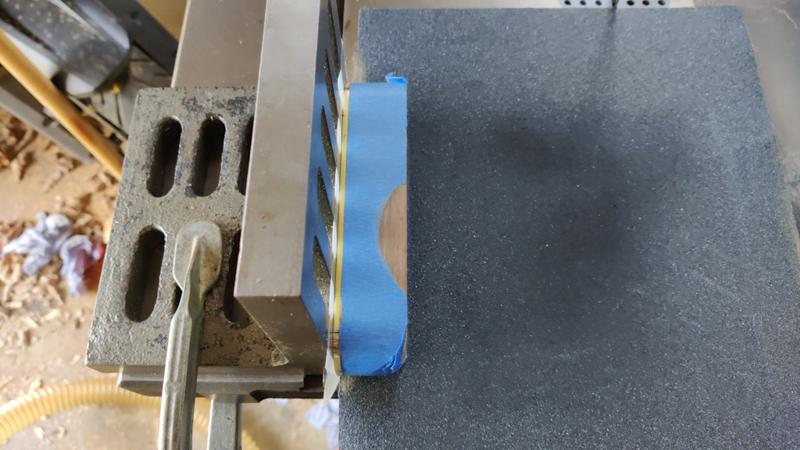
This also had the advantage that most of the brass swarf stays in line with the brass base and doesn't get rubbed into the wood.
I kept going until I was sanding wood as well as brass and then moved onto the corners, which I dealt with in the portable workbench vice with a file (this photo was actually taken after I'd sanded only one side, hence the masking tape still being there):
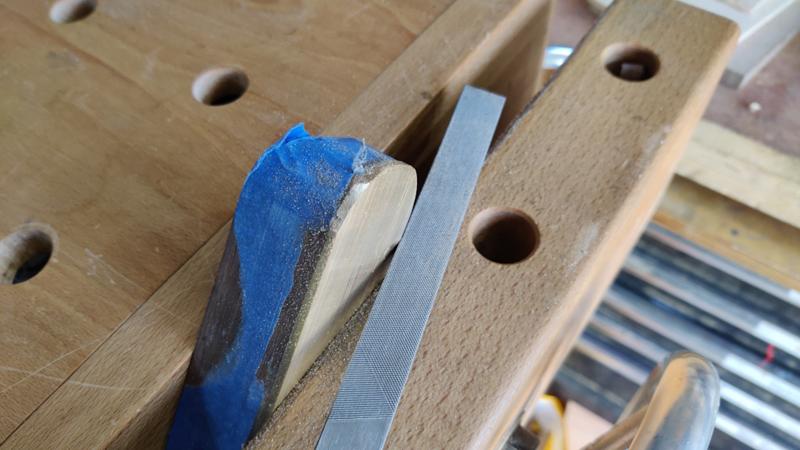
The body was still a millimetre or so too tall at this point (it needs to be 30 mm high to fit into the groove in the tool chest shooting board), so the top got planed down, taking light cuts and checking with the shooting board groove.
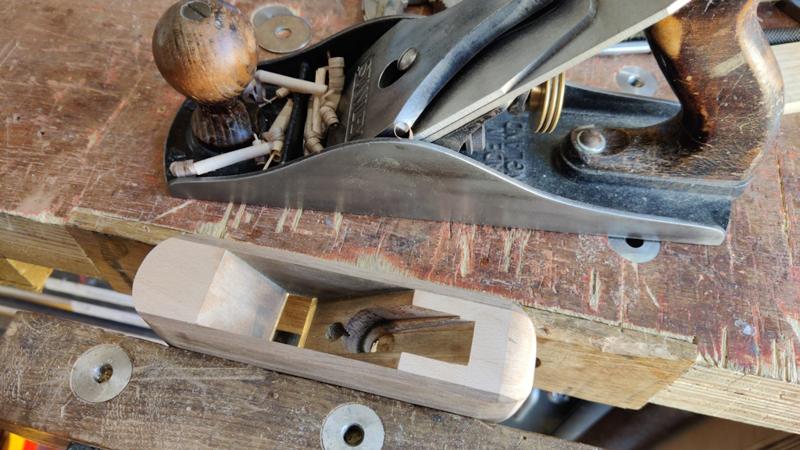
After doing that, I used the little Parkside disk sander to reshape the curve on the top/rear edge. The last sanding job was to sort out the inside faces (which had got a bit oily from when I flattened the base). I did this using some strips of mesh sandpaper held onto a 1 mm thick steel rule:
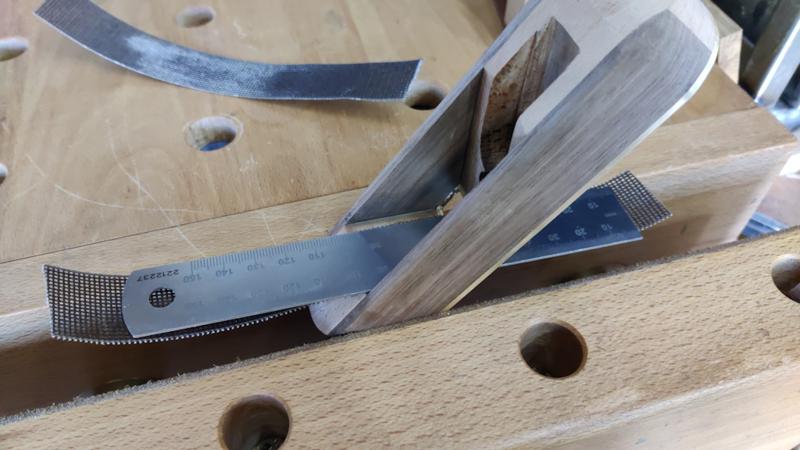
The final job was to apply a couple of coats of my favourite finish, making sure the finish didn't get into the tapped hole:
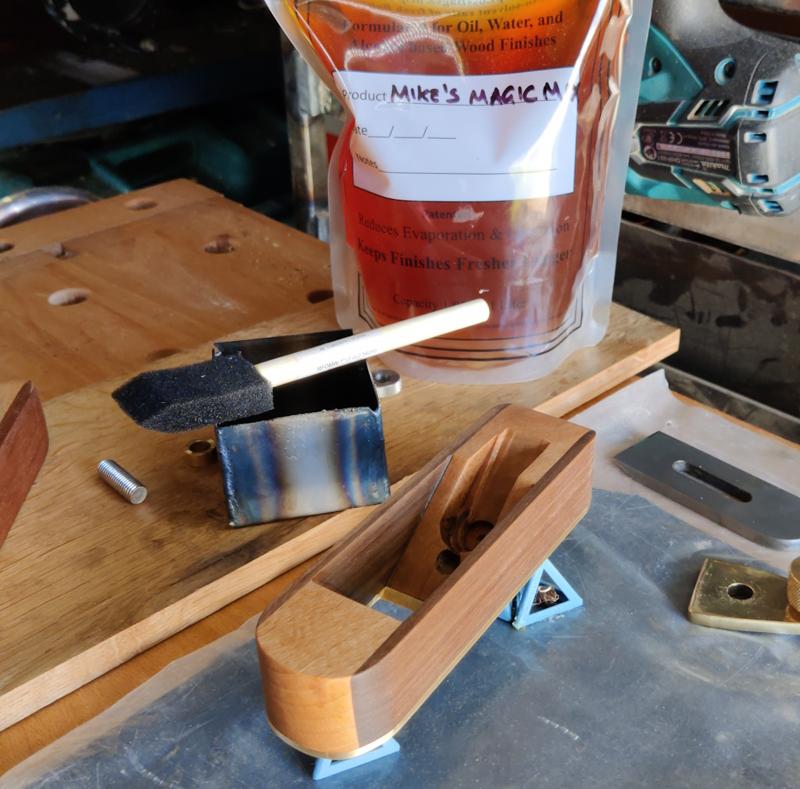
After the first coat of oil, I glued the threaded rod in with Araldite and then applied a second coat.
It could then be assembled ...
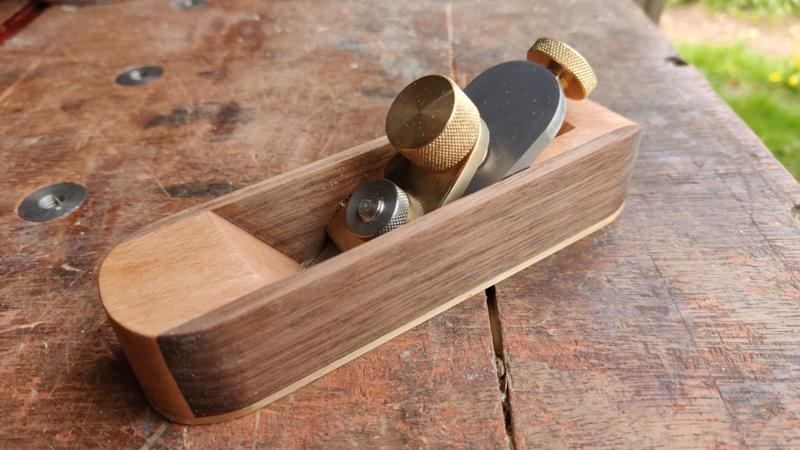
... and tested, first on edge grain ...
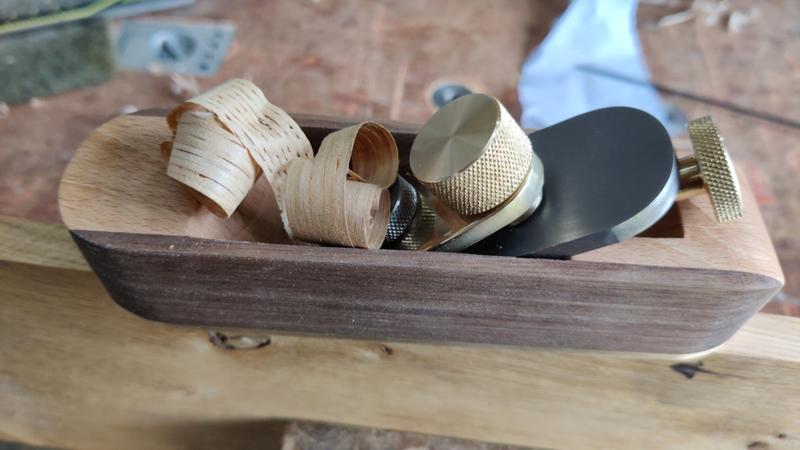
... and then on end grain (which is what this plane is mostly intended for):
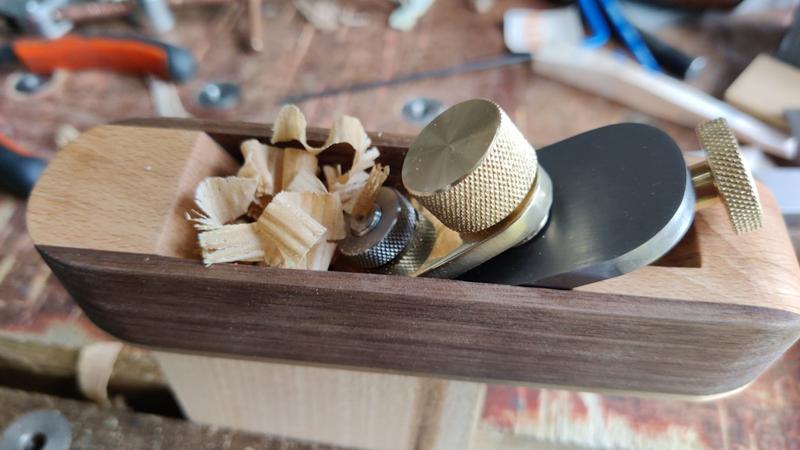
It works really well on the tool chest shooting board:
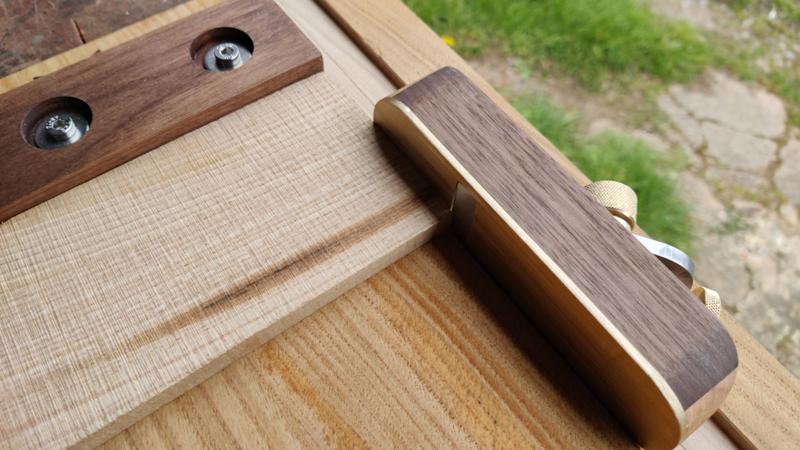
Finally, I tried using it to plane the face of a board, despite this not really being an intended use. It worked remarkably well and didn't even leave any tracks from the blade corners, which surprised me as I hadn't cambered the blade even slightly (I probably just got lucky).
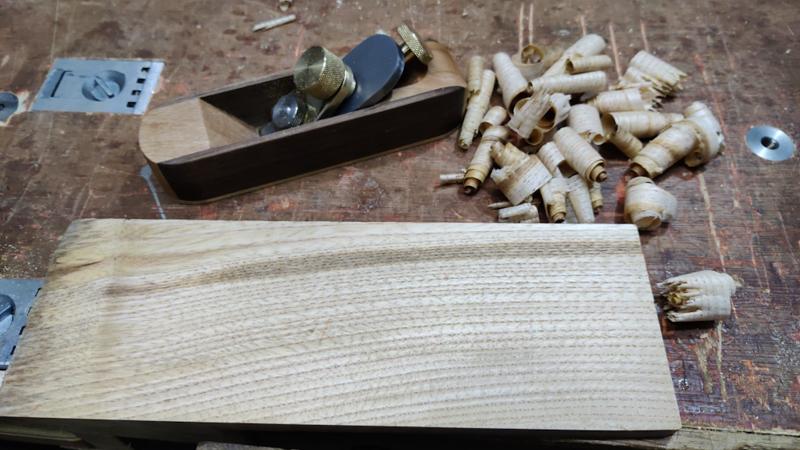
I quite enjoyed planing the face of the little board with the little plane; it's not something I've ever done with a block plane (and I won't be throwing my #4 away any time soon!) but there's something really satisfying about preparing edge, face and end grain of a board using a plane that you've made yourself.
Out of interest, I thought I'd weigh three block planes for comparison (not that the weight matters especially - none of them are heavy):
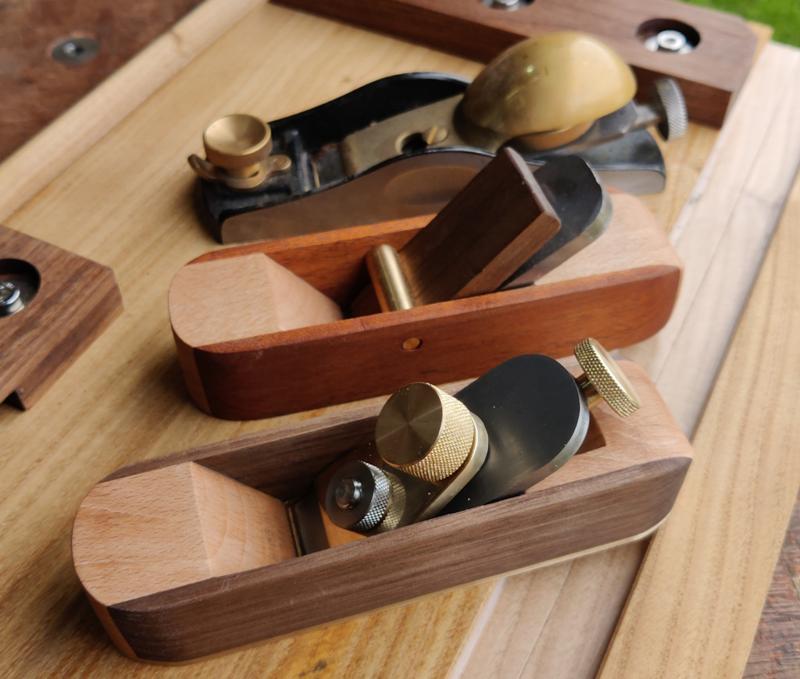
The metal block plane weighs 750 g, the all-wooden-bodied plane weighs 225 g and the new one weighs 415 g.
It feels very comfortable in the hand and is a lot easier to adjust for a fine cut than the all-wooden-bodied plane. It's very easy to clear the shavings: just turn the plane upside down and they fall out. There are definitely things that I could improve if I could face the idea of making another one, but overall I'm really pleased with how it turned out.

That left the mouth looking like this:

My portable workbench provided a handy method of holding the body a bit higher up to make the filing job more comfortable:

After filing:

I want the sides of the plane (especially the right-hand side) to be at 90° to the base and I was a bit concerned that if I just attacked the sides of the brass base with a file, I could easily file away some of the wood and end up out-of-square. To avoid that, I got an angle plate and taped some UHMW-PE tape to it (UHMW-PE is very low friction tape):

After clamping the angle plate down to the bandsaw table and pushing a sheet of 120 grit wet-and-dry paper up against it, I could press the base of the body against the taped angle plate and rub it back and forth to sand the side:

This also had the advantage that most of the brass swarf stays in line with the brass base and doesn't get rubbed into the wood.
I kept going until I was sanding wood as well as brass and then moved onto the corners, which I dealt with in the portable workbench vice with a file (this photo was actually taken after I'd sanded only one side, hence the masking tape still being there):

The body was still a millimetre or so too tall at this point (it needs to be 30 mm high to fit into the groove in the tool chest shooting board), so the top got planed down, taking light cuts and checking with the shooting board groove.

After doing that, I used the little Parkside disk sander to reshape the curve on the top/rear edge. The last sanding job was to sort out the inside faces (which had got a bit oily from when I flattened the base). I did this using some strips of mesh sandpaper held onto a 1 mm thick steel rule:

The final job was to apply a couple of coats of my favourite finish, making sure the finish didn't get into the tapped hole:

After the first coat of oil, I glued the threaded rod in with Araldite and then applied a second coat.
It could then be assembled ...

... and tested, first on edge grain ...

... and then on end grain (which is what this plane is mostly intended for):

It works really well on the tool chest shooting board:

Finally, I tried using it to plane the face of a board, despite this not really being an intended use. It worked remarkably well and didn't even leave any tracks from the blade corners, which surprised me as I hadn't cambered the blade even slightly (I probably just got lucky).

I quite enjoyed planing the face of the little board with the little plane; it's not something I've ever done with a block plane (and I won't be throwing my #4 away any time soon!) but there's something really satisfying about preparing edge, face and end grain of a board using a plane that you've made yourself.
Out of interest, I thought I'd weigh three block planes for comparison (not that the weight matters especially - none of them are heavy):

The metal block plane weighs 750 g, the all-wooden-bodied plane weighs 225 g and the new one weighs 415 g.
It feels very comfortable in the hand and is a lot easier to adjust for a fine cut than the all-wooden-bodied plane. It's very easy to clear the shavings: just turn the plane upside down and they fall out. There are definitely things that I could improve if I could face the idea of making another one, but overall I'm really pleased with how it turned out.
Wow, what a result.
I really like the way that all the circles and semicircles visually "rhyme" together.
And I'm sure it's true that "there's something really satisfying about preparing edge, face and end grain of a board using a plane that you've made yourself".
Well done!



I really like the way that all the circles and semicircles visually "rhyme" together.
And I'm sure it's true that "there's something really satisfying about preparing edge, face and end grain of a board using a plane that you've made yourself".
Well done!
Very nice Al
Is there a precedent for brass soled wooden planes or is this the first ? I recall seeing brass sided wood planes though.
Is there a precedent for brass soled wooden planes or is this the first ? I recall seeing brass sided wood planes though.
Dr.Al
Old Oak
Wow, what a result.
I really like the way that all the circles and semicircles visually "rhyme" together.
And I'm sure it's true that "there's something really satisfying about preparing edge, face and end grain of a board using a plane that you've made yourself".
Well done!

Thanks Andy
Thanks Andy. No idea on precedent. I had just assumed it was something that people did, but what do I know?Very nice Al
Is there a precedent for brass soled wooden planes or is this the first ? I recall seeing brass sided wood planes though.
I just did a search on eBay for "brass soled plane" and then a general image search. Both showed plenty of interesting examples. Often user made or modified, but not always.Thanks Andy
Thanks Andy. No idea on precedent. I had just assumed it was something that people did, but what do I know?
I then did a less virtual search in my own workshop and found two nice pattern maker's shaves with brass soles. I tried them out on a bit of oak and there was no marking at all. Nor is there any from my brass faced mortice gauges.
I'm sure it will all be fine.
Pete Maddex
Nordic Pine
Turned out nice again.
I like using home made tools, I was using my coping saw bowsaw at the weekend.
Pete
I like using home made tools, I was using my coping saw bowsaw at the weekend.
Pete
Mike G
Petrified Pine
I was using my coping saw bowsaw at the weekend.
Where's the photos, Pete?
Pete Maddex
Nordic Pine
It was used to make a replacement hinge for the shower screen than broke as my wife was cleaning it.Where's the photos, Pete?
 DSCF0039 by pete maddex, on Flickr
DSCF0039 by pete maddex, on FlickrPete
Alasdair
New Shoots
Oh crap, another Dr Al addictive post. Thats me now hooked into keep coming back and work wont get done because of it. 
Stunning work yet again this looks fantactic.
Stunning work yet again this looks fantactic.
Dr.Al
Old Oak
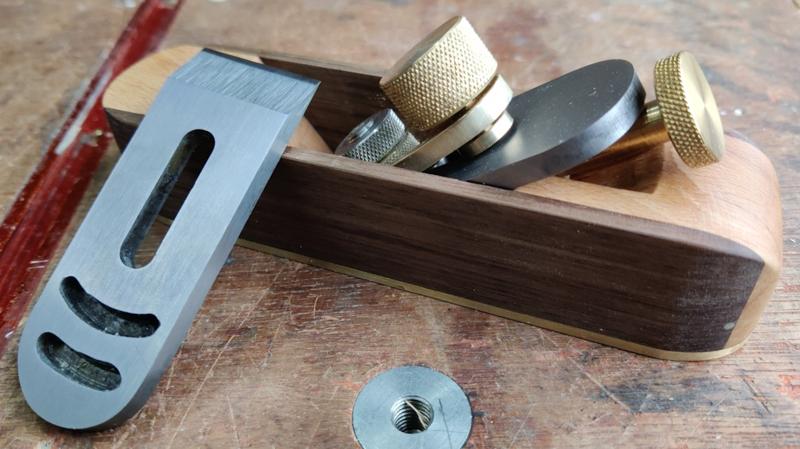
I decided to make a spare blade for the block plane. It's always handy having two blades (even if only because it occasionally allows me to lazy and put off sharpening for a bit!).
This one was a bit of an ordeal to be honest. Making it proceeded in much the same way as the last blade (and took about 2 hours). I then hardened it and tempered it as before. When I came to sharpen it, I was finding it impossible to get an edge on it, suggesting it wasn't properly hardened. This will be for one of the following reasons, but I've no idea which:
- I didn't heat it up enough before quenching when hardening.
- I took too long going from heating to quenching.
- I overcooked it when tempering.
Whichever was the cause, it needed to be dealt with, so I went back to the start and heated it up to cherry red before plunging in oil. I decided to use the domestic fan oven for the tempering process this time, so I set the oven on 220°C and chucked it in. With hindsight, I should have wrapped it in something to even out the heat a bit: when I came back to it a little later, the tip was blue, suggesting it had reached a temperature in excess of 285°C (according to the chart in the book I use for reference when heat treating. I wouldn't have expected that from a fan oven (and I've tempered stuff in there before with no issues).
Ah well, back to square one again. Third time lucky thankfully (I was going to give up if it didn't work this time): I heated it back up to cherry red, plunged it in oil, tempered with the blow torch again this time and then the process of grinding and sharpening went nice and smoothly. All's well that ends well as the bard put it.
Mike G
Petrified Pine
I'm trying to picture your cam mechanism working, Al, and I wondered if there was any tendency for the blade to move sideways when turning the adjusting knob? I'm picturing the friction between the adjuster in the slot in the iron exerting a sideways force when the knob is turned, whereas the intention is only to slide the blade in or out. Is that an issue at all?
Dr.Al
Old Oak
I haven't noticed it yet, but I guess we'll see. So far I've found it very easy to nudge it straight using the cam & then set the depth using the screw. Time will tell how consistent it is.I'm trying to picture your cam mechanism working, Al, and I wondered if there was any tendency for the blade to move sideways when turning the adjusting knob? I'm picturing the friction between the adjuster in the slot in the iron exerting a sideways force when the knob is turned, whereas the intention is only to slide the blade in or out. Is that an issue at all?
I'd like to make one more Norris-esque with a pin in a hole driving the blade up & down & side-to-side. However, I'm not convinced there's space in a block plane for all that (especially a wooden bodied one)
